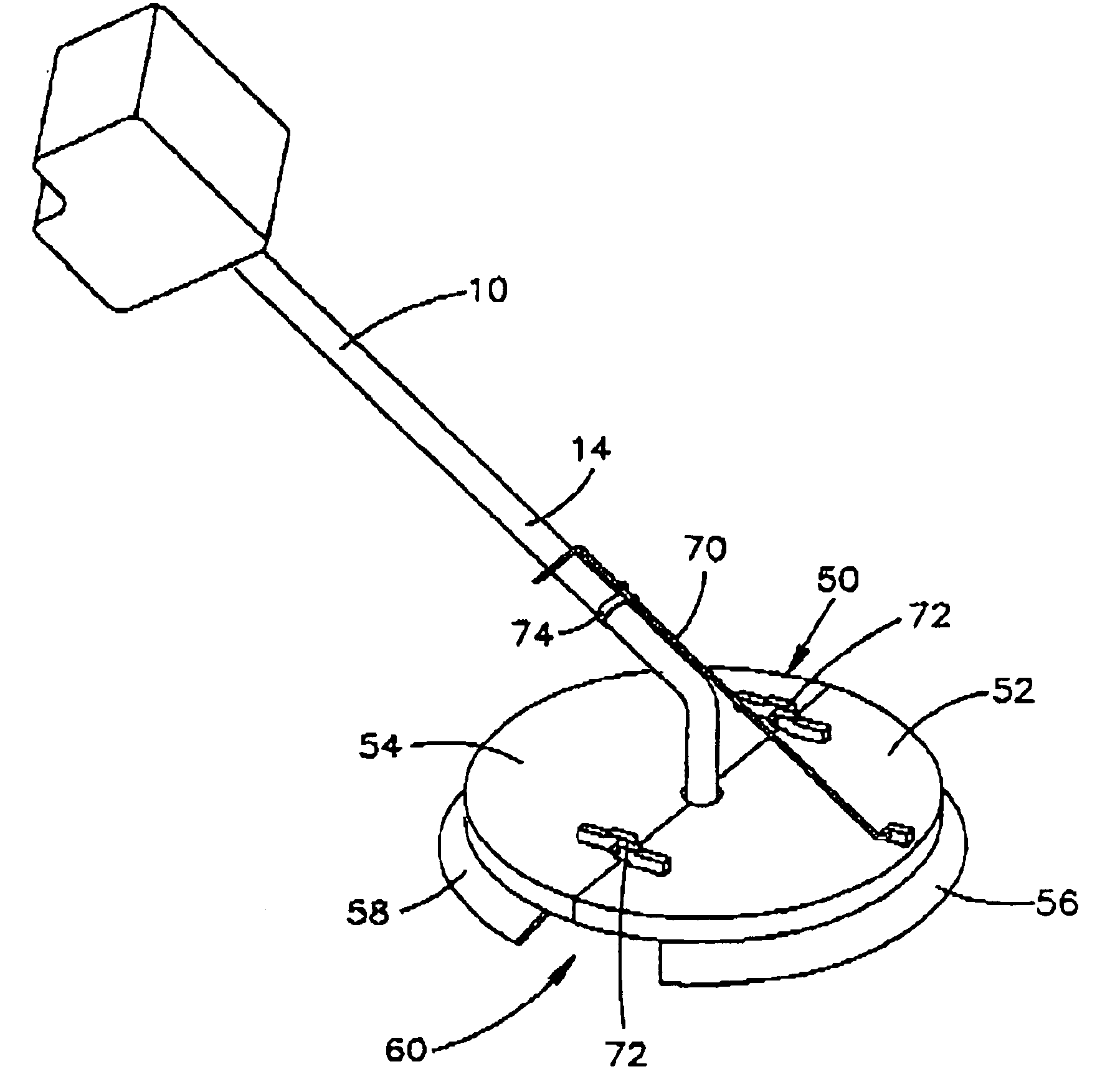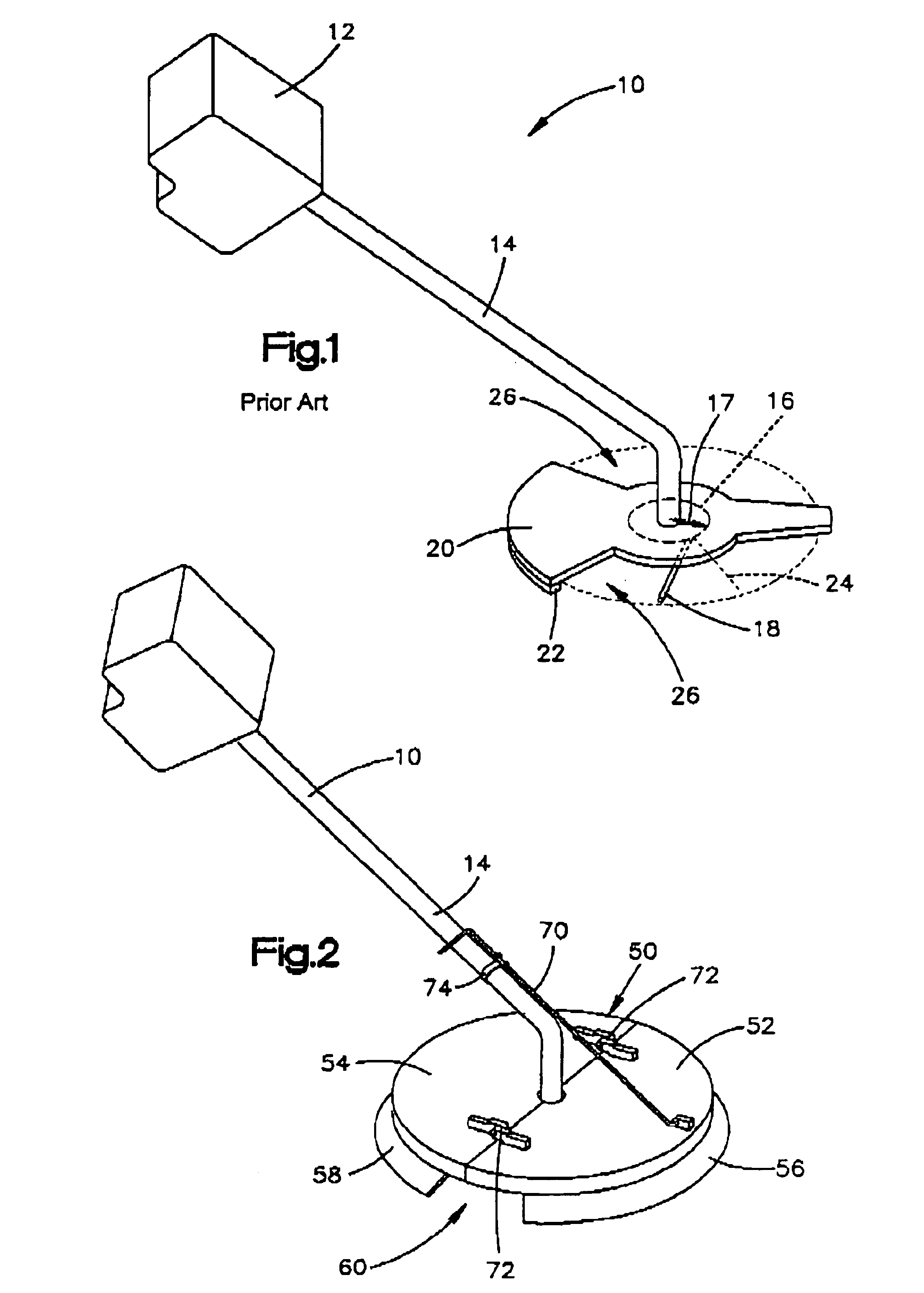Weed trimmer safety guard
a safety guard and weed trimmer technology, applied in metal working apparatus, agriculture tools and machines, agriculture, etc., can solve the problems of unsightly mess that must be removed at the expense of time and labor, only limited protection against injury, and increase the cutting so as to prevent flexible materials, improve the performance of prior art weed trimmers, and increase the cutting performance
- Summary
- Abstract
- Description
- Claims
- Application Information
AI Technical Summary
Benefits of technology
Problems solved by technology
Method used
Image
Examples
embodiment 50
[0020]Referring now to FIG. 2, one embodiment of the present invention is illustrated. A circular adjustable covering assembly 50 is shown attached to the prior art weed trimmer 10 of FIG. 1. The assembly, according to the present invention, consists of a front semicircular element 52 and a rear semicircular element 54, both attached about the shaft 14 above the typical prior art weed trimmer guard 20. Although, in the present embodiment, the embodiment 50 is attached directly on top of a pre-existing rear facing guard 20, it should be readily understood that the present invention may be utilized in place of the typical prior art rear guard element 20.
[0021]The semicircular front and rear cover elements 52 and 54 each have a partially semicircular flange element 56 and 58 associated with it, respectively. These flange elements 56 and 58 help to compel weeds, vegetation, tall grasses, and other elements desired to be cut by the weed trimmer 10 cutting element 18 (not shown) toward th...
embodiment 60
[0026]FIG. 4 is a more detailed view of the rod 70, locking element 74, and spring hinge element 72 as incorporated in the embodiment 60 shown in FIG. 3. The locking mechanism 74 is a tensioned metal butterfly spring device. The rod 70 is disposed between an upper finger projection 82 and a lower finger projection 84 through apertures 86 and 88, respectively. A base element 80 of the locking means 74 is clamped about the prior art weed trimmer shaft 14. By squeezing the upper butterfly element 82 and the lower butterfly element 84 toward each other, tension is released from the spring-like action of the elements 82 and 84, which would otherwise attempt to spread apart from each other and exert pressure on the rod element 70 through their interface with their respective apertures 86 and 88 with the rod element 70. By removing this tension, by squeezing 82 towards 84, the rod 70 can be easily slid upward or downward through the apertures 86 and 88 until the front cover 62 is compelled...
embodiment 90
[0029]Referring now to FIG. 5, another embodiment of the present invention 90 is depicted. Here, a front element 92 and a rear clement 94 are attached to a prior art weed trimmer shaft 14. In contrast to the embodiment of the invention depicted in FIG. 4, the invention embodiment 90 shown in FIG. 5 has two triangular shaped front and rear elements 92 and 94. Between the outer edge 93 of the rear element 94 and the outer edge 95 of the front element 92, a large aperture 96 is formed on both sides of the weed trimmer assembly. The gap 96 may be desired by a user who wishes some of the materials being mulched by the cutting element 18 to be expelled to the sides of the weed trimmer assembly. It may also be preferable to have a visual gap 96 so that a user of a conventional weed trimmer 10 can see the results of the trimming action by the cutting element 18 as he progresses through his cutting applications.
[0030]Referring again to FIG. 4, the front cover element 62 and rear cover elemen...
PUM
 Login to View More
Login to View More Abstract
Description
Claims
Application Information
 Login to View More
Login to View More - R&D
- Intellectual Property
- Life Sciences
- Materials
- Tech Scout
- Unparalleled Data Quality
- Higher Quality Content
- 60% Fewer Hallucinations
Browse by: Latest US Patents, China's latest patents, Technical Efficacy Thesaurus, Application Domain, Technology Topic, Popular Technical Reports.
© 2025 PatSnap. All rights reserved.Legal|Privacy policy|Modern Slavery Act Transparency Statement|Sitemap|About US| Contact US: help@patsnap.com



